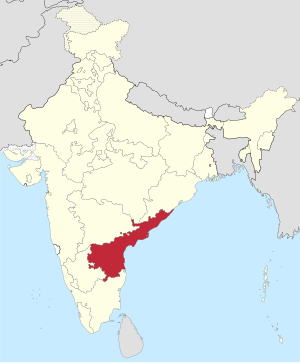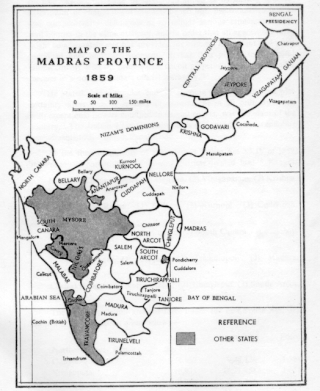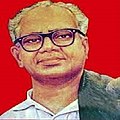Andhra State
Former state of India (1953–56) in Andhra Pradesh From Wikipedia, the free encyclopedia
Former state of India (1953–56) in Andhra Pradesh From Wikipedia, the free encyclopedia
Andhra State (IAST: Āndhra Rāṣṭramu; IPA: [ˈɑːndʰrʌ raːʂʈɾamu]) was a state in India created in 1953 from the Telugu-speaking northern districts of Madras State.[1] The state was made up of this two distinct cultural regions – Rayalaseema and Coastal Andhra. Andhra State did not include all Telugu-speaking areas, as it excluded some in Hyderabad State. Under the State Reorganisation Act of 1956, Andhra State was merged with the Telugu-speaking regions of Hyderabad State to form Andhra Pradesh.
Andhra State Āndhra Rāṣṭramu | |||||||||
|---|---|---|---|---|---|---|---|---|---|
Former State 1953–1956 | |||||||||
 Location of Andhra State Āndhra Rāṣṭramu in India | |||||||||
| Country | |||||||||
| Region | South India | ||||||||
| Before was | Part of Madras State | ||||||||
| Formation | 1 October 1953 | ||||||||
| Dissolution | 1 November 1956 (by States Reorganisation Act, 1956) | ||||||||
| Capital and largest city | Kurnool | ||||||||
| Government | |||||||||
| • Type | Federated state | ||||||||
| • Governor | |||||||||
• 1953–1956 | Chandulal Madhavlal Trivedi (First and Last) | ||||||||
| • Chief minister | |||||||||
• 1953–1954 | Tanguturi Prakasam (First) | ||||||||
• 1955–1956 | Bezawada Gopala Reddy (Last) | ||||||||
| Time zone | UTC+05:30 (IST) | ||||||||
| |||||||||


In an effort to protect the interests of the Telugu people of Madras State, Potti Sreeramulu attempted to force the Madras State government to listen to public demands for the separation of Telugu-speaking districts (Rayalaseema and Coastal Andhra) from Madras State to form Andhra State. He went on a lengthy fast and only stopped when Prime Minister Jawaharlal Nehru made a promise to form Andhra State. Later, after witnessing no real progress towards the creation of Andhra State, he started fasting again in Maharshi Bulusu Sambamurti's house in Madras, on 19 October 1952. This caught people's attention despite the disapproval of the fast by the Andhra INC. The government did not make a clear statement about the formation of a new state, despite several strikes and demonstrations by Telugu people. At midnight of 15 December (i.e., early 16 December 1952), Sreeramulu died while fasting. The house has been preserved as a monument by the state government.[2]
During Sreeramulu's death procession, people shouted slogans praising his sacrifice. Later, they went into a frenzy and began to destroy public property. The news spread quickly and created an uproar among the people in far off places like Chirala, Srikakulam, Visakhapatnam, Vijayawada, Rajahmundry, Eluru, Bhimavaram, Ballary, Guntur, Tenali, Ongole and Nellore. Seven people were killed in clashes with police in Anakapalle and Vijayawada. The popular agitation continued for three to four days disrupting normal life in the Madras and Andhra regions. On 19 December 1952, the Prime Minister of the country Jawaharlal Nehru made an announcement about the formation of a separate state for the Telugu-speaking people of Madras State. The central government appointed K. N. Wanchoo, Chief Justice of the Rajasthan High Court,[3] to look into issues related to formation of Andhra State. Parliament passed the Andhra State Act in September 1953.[4]
On 1 October 1953, 11 districts in the Telugu-speaking portion of Madras State became the new Andhra State with Kurnool as the capital. Tanguturi Prakasam Pantulu (also known as Andhra Kesari – "The Lion of Andhra") became the first Chief Minister of the new state.[5]
Formation of this first "linguistic state" paved the way to creation of more and provided an opportunity for these states to develop independently, linguistically and economically, each of them having a state to support.[6][7]
Governors of Andhra State, Andhra State consisted of Coastal Andhra and Rayalaseema regions. This state was carved out of Madras State in 1953.
| # | Name | Portrait | From | To | Term length |
|---|---|---|---|---|---|
| 1 | Chandulal Madhavlal Trivedi |  |
1 October 1953 | 31 October 1956 | 3 years, 30 days |
On 1 October 1953, 11 districts in the Telugu-speaking portion of Madras State became the new Andhra State with Kurnool as the capital. [8]
| # | Portrait | Chief Minister (Lifespan) Constituency |
Term of office | Election (Term) |
Party | Government | Appointed by (Governor) | |||
|---|---|---|---|---|---|---|---|---|---|---|
| Term start | Term end | Duration | ||||||||
| 1 |  |
Tanguturi Prakasam టంగుటూరి ప్రకాశం (1913–1996) – |
1 October 1953 | 15 November 1954 | 1 year, 45 days | 1952 (1st) |
Indian National Congress | Prakasam | Chandulal Madhavlal Trivedi | |
| President's rule imposed during the period (15 November 1954 – 28 March 1955)[a] | ||||||||||
| 2 |  |
Bezawada Gopala Reddy బెజవాడ గోపాల రెడ్డి (1913–1996) MLA for Atmakur |
28 March 1955 | 31 October 1956 | 1 year, 217 days | 1955 (2nd) |
Indian National Congress | Gopala | Chandulal Madhavlal Trivedi | |
Andhra State consisted of North Andhra, Coastal Andhra and Rayalaseema regions. This state was carved out of Madras State in 1953. Neelam Sanjeeva Reddy served as deputy CM under Prakasam and Bezawada Gopala Reddy.[10] Later, the Andhra state was merged with Telangana province of Hyderabad to form Andhra Pradesh in November 1956.
| No. | Portrait | Name | Constituency | Term of office | Assembly
(election) |
Party | |||
|---|---|---|---|---|---|---|---|---|---|
| From | To | Days in office | |||||||
| 1 |  |
Neelam Sanjiva Reddy | – | 1 October 1953 | 15 November 1954 | 1 year, 45 days | 1st | Indian National Congress | |
| – |  |
Vacant[a] | N/A | 15 November 1954 | 28 March 1955 | 133 days | N/A | ||
| 2 |  |
Neelam Sanjiva Reddy | Kalahasti | 30 March 1955 | 31 October 1956 | 1 year, 215 days | Indian National Congress | ||
| № | Name (Constituency) |
Portrait | Term | Party | Assembly (Election) | ||
|---|---|---|---|---|---|---|---|
| 1 | Puchalapalli Sundarayya పుచ్చలపల్లి సుందరయ్య (Gannavaram) |
 |
1955 | 1956 | Communist Party of India | First Assembly (1955 election) | |
During the time of the formation of Andhra State, it had only eleven districts.[11][12]
| Official name | Division | Map |
|---|---|---|
| Srikakulam | Coastal Andhra Region | |
| Visakhapatnam | ||
| East Godavari[b] | ||
| West Godavari | ||
| Krishna[c] | ||
| Guntur | ||
| Nellore | ||
| Chittoor | Rayalaseema Region | |
| Kadapa | ||
| Anantapuram | ||
| Kurnool |
The Visalandhra, Vishalandhra or Vishala Andhra was a movement in post-independence India for a united state for all Telugu speakers, a Greater Andhra (Telugu: విశాలాంధ్ర Viśālāndhra). This movement was led by the Communist Party of India under the banner of Andhra Mahasabha with a demand to merge all the Telugu-speaking areas into one state.[citation needed] (The Communist Party of India demanded for the formation of similar linguistic states across India.) The movement succeeded and a separate state of Andhra Pradesh was formed by merging Telugu-speaking areas of Hyderabad State (Telangana) with Andhra State on 1 November 1956 as part of the States Reorganisation Act. (Andhra State had been previously carved out of Madras State on 1 October 1953.) However, on 2 June 2014, Telangana State was separated back out of Andhra Pradesh and the Vishalandhra experiment came to an end. The residual Andhra Pradesh now has approximately the same borders.

On 1 November 1956 Andhra State and the Telangana region of Hyderabad State were merged to form the united Telugu-speaking State of Andhra Pradesh. Non-Telugu-speaking parts of Hyderabad State were merged with Bombay State and Karnataka.

After a reorganization in 1956, regions of the state west of the red and blue lines merged with Bombay and Mysore States, respectively, and the rest of the state (Telangana) was merged with Andhra State to form Andhra Pradesh State.
Paragraph 382 of the SRC report dated 30 September 1955 said, "opinion in Andhra is overwhelmingly in favour of the larger unit, public opinion in Telangana has still to crystallize itself. Important leaders of public opinion in Andhra themselves seem to appreciate that the unification of Telangana with Andhra, though desirable, should be based on a voluntary and willing association of the people and that it is primarily for the people of Telangana to make a decision about their future".
While the Fazal Ali commission emphasizes the necessity and benefits Visalandhra[clarification needed], the report suggests that the process of merging may only be done after 5 years. In Paragraph 386, it states, "...for the present the Telangana area is to constitute into a separate State, which may be known as Hyderabad State with provision for its unification with Andhra after the general elections likely to be held in or about 1961 if by a two-thirds majority the legislature of the residency Hyderabad State expresses itself in favor of such unification".
Paragraph 387 goes on to say that the advantage of this arrangement will be that while the objective of the unification of the Andhras will neither be blurred nor impeded during a period of five or six years, the two governments may have stabilized their administrative machinery and, if possible, also reviewed their land revenue systems, etc., the object in view being the attainment of uniformity. The intervening period may incidentally provide an opportunity for allaying apprehensions and achieving the consensus of opinion necessary for a real union between the two states.[13]
From the content of Paragraph 387, the commission's main objective was to attain uniformity by achieving adequate administrative machinery and proper land review systems in the recently formed Andhra State and the new State of Hyderabad being formed and this duration could also be incidentally utilized for gaining consensus opinion for the merger of the two states. In line with SRC opinion, the elected leaders of both states decided for an immediate merger by achieving consensus by two-thirds majority strength in both assemblies of these states.
The Hyderabad chief minister, in his letter to the INC president, said Communist parties supported the merger for their political calculations.[14] The Hyderabad PCC chief said the overwhelming majority of INC party members opposed the merger, that Communists were elected in special circumstances in 1951, that Visalandhra was not a political issue in 1951, and that the Assembly does not reflect the people's view on the issue. He also said 80% of INC delegates who were elected in 1955 opposed the merger. The government had to provide additional security for Communist leaders who supported the Visalandhra.[15]
In the Hyderabad Assembly, on 3 December 1955, 147 of 174 MLAs expressed their view. 103 (including Marathi and Kannada MLAs) supported the merger, 16 were neutral, and 29 opposed it.[citation needed] Among Telangana MLAs, 59 supported the merger and 25 opposed it. Out of 94 Telangana MLAs in the assembly, 36 were Communists (PDF), 40 were INC, 11 were Socialist party (SP), and 9 were independents.[clarification needed] Voting did not take place on the resolution because Telangana proponents insisted on including the phrase "As per the wishes of people" in the resolution.[16][17]
To convince the leadership of Telangana to join the new state, an agreement was reached between the leaders of both sides. This came to be known as the Gentlemen's Agreement. The agreement allowed the formation of the State of Andhra Pradesh in 1956, against the SRC's recommendations of waiting until 1961 to get the approval of 2/3 of Telangana State assembly after the 2 cycles of elections in Telangana State.
Seamless Wikipedia browsing. On steroids.
Every time you click a link to Wikipedia, Wiktionary or Wikiquote in your browser's search results, it will show the modern Wikiwand interface.
Wikiwand extension is a five stars, simple, with minimum permission required to keep your browsing private, safe and transparent.